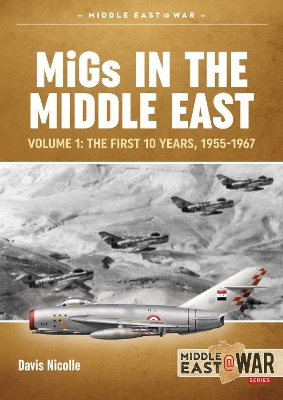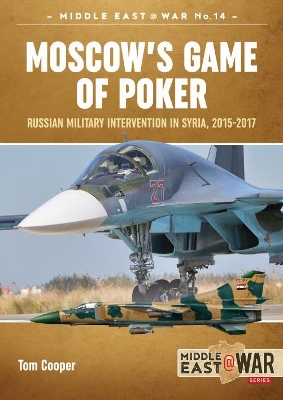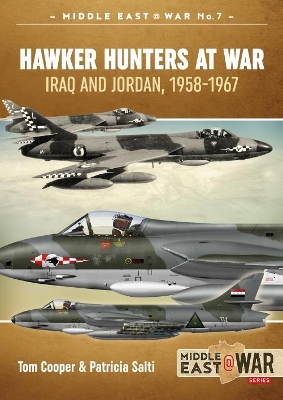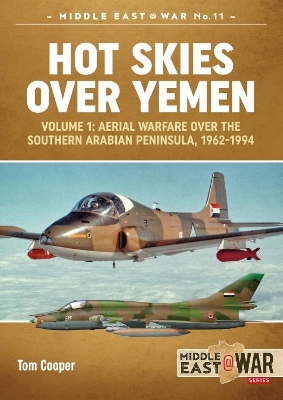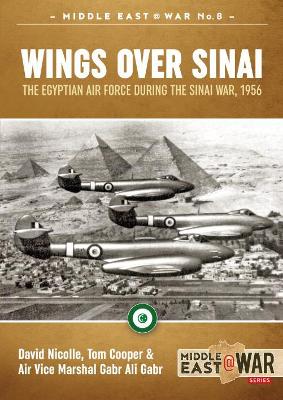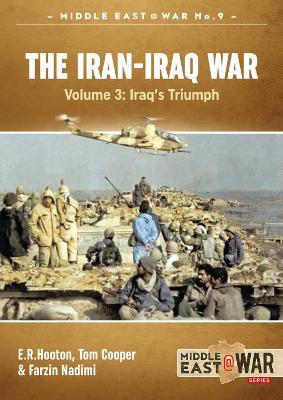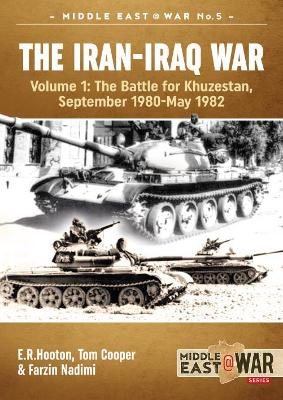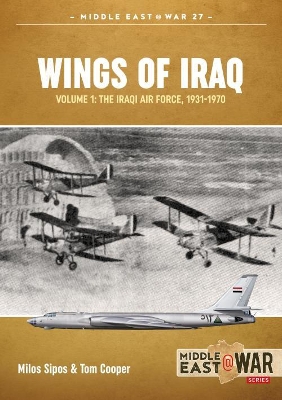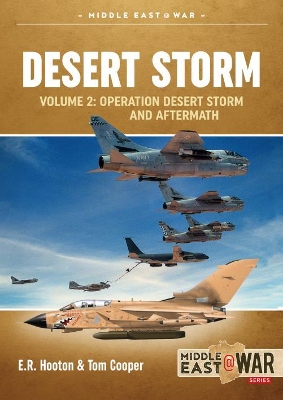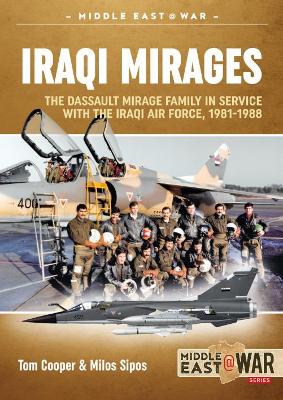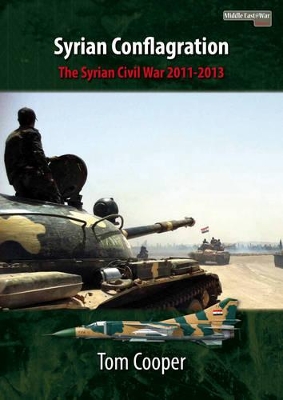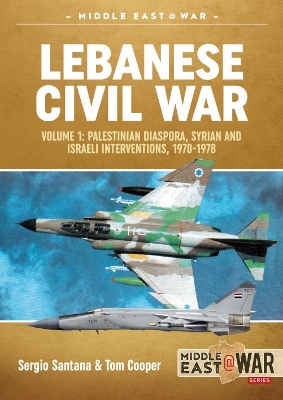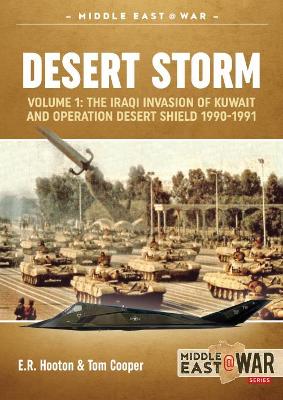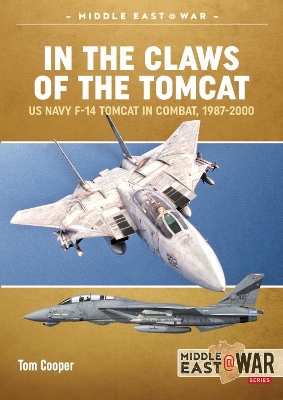Middle East@War
33 total works
While the first generation of MiG jet fighter - the MiG-15 - saw only a relatively brief service in Egypt, its more efficient and uprated successor, the MiG-17F, entered service in bigger numbers, and then formed the backbone of additional air forces around the Middle East. The MiG-17PF became the first radar-equipped combat aircraft while the MiG-19 became the first supersonic fighter flown by the air forces of Egypt and Iraq, in the period 1958-1963. In Morocco and Algeria, the MiG-17 was the first and the only jet fighter in service during the first half of the 1960s.Unsurprisingly, MiG-15s, MiG-17s and MiG-19s thus served with many different units and - especially in Egypt and Algeria, and also in Syria - wore a wide range of very different, and often very colourful unit insignia and other markings. They were also flown by many pilots who subsequently played crucial roles in the future of their nations.
Based on original documentation and extensive interviews with veterans, and richly illustrated, MiGs in the Middle East, Volume 1 is a unique source of reference on the operational history of MiG-15, MiG-17, and MiG-19 fighter jets in Algeria, Egypt, Iraq, Morocco, and Syria from 1955 until 1956. This is the first volume in a mini-series.
This is a detailed history of the operational service of this Soviet-manufactured interceptor and its fighter-bomber variants in service with Algerian, Egyptian, Iraqi, Libyan, and Syrian air forces, since 1974. While Egypt purchased only a handful before its final break with Moscow, and Algeria limited related acquisitions, Iraq, Libya and Syria continued purchasing advanced variants in significant numbers through the 1980s. The units operating MiG-23s were soon transformed into the backbone of the military services in question, and they saw combat service in a number of intensive military conflicts. In the 1980s, they fought against Israeli jets over Lebanon, against the Iranians in the Iran-Iraq War, and confronted US Navy's F-14s on numerous occasions off Libya. In 1991 Iraqi MiG-23s were deployed in combat against the US-led coalition's F-15s. Indeed, in Syria, different versions of MiG-23 continue flying combat operations today.
Illustrated with over 110 photographs - many of these never published before -colour profiles and a dozen maps, this volume provides a unique point of reference, revealing much detail about camouflage patterns, unit insignia and aircraft markings.
To many, the performance of the Russian military - and especially...Read more
To many, the performance of the Russian military - and especially the Russian Air-Space Force (VKS) - in this war was a clear demonstration of advanced technology, improved training, fearsome firepower, and great mobility.
To others, the military operation only experienced limited success and exposed a number of weaknesses. Foremost between the latter are aircraft ill-suited to the necessities of expeditionary warfare, and a gross lack of advanced weaponry and equipment.
While the military component of their intervention can only be described as providing clear evidence that the Russian military is in no condition to directly challenge the NATO's eastern frontiers, it cannot be denied that through this action Moscow instrumented a turning point in the Syrian Civil War, and indeed one on geo-strategic plan. Organized and run in cooperation with very diverse allies - ranging from the Islamic Revolutionary Guards Corps of Iran (IRGC), Hezbollah of Lebanon, the Kurdishan Workers Party (PKK) and a myrad of local warlords and their armed militias - their combination of intentional bombardment of insurgent-controlled parts of Syria, and indirect protection for the IRGC's own military intervention in the country from a possible counter-intervention of the West, the Russians did succeed in saving the regime of the Syrian President Bashar al-Assad. Through this, this campaign created an absurd precedent in newest history: a brutal dictatorship involved in systematic elimination of hundreds of thousands on industrial scale, and frequently with help of chemical weapons, was even made popular within circles of far-right and far-left alike around the World. In turn, the resulting flow of refugees destabilized the European Union and large parts of the NATO - two parties considered the actual primary opponents by the government in Moscow - and increased the popularity of the President Vladimir Putin to unprecedented levels.
Illustrated by over 130 photographs, maps and colour profiles, 'Moscow's Game of Poker' is providing a clear outline of the participants in this extremely complex conflict, and areas it impacts. It is providing a unique and in-depth study of Moscow's political aims, strategy, doctrine, target selection process, military technology and tactics, day-by-day operations, and the way the Russian Federation cooperates with diverse local allies. This story is told in combination with an exclusive insight into the similar campaign run by what is left of the Syrian Arab Air Force.
Hawker Hunters at War covers every aspect of Hunter's service in the two countries, from in-depth coverage of negotiations related to their export to Iraq and Jordan, to all-important details of their operational service during 1958-67. It culminates in detailed examination of their role in the June 1967 Arab-Israeli War (also known as the 'Six Days War') and extensive tables listing all aircraft delivered and their fates. Almost entirely based on interviews with retired commanding officers and pilots of the former Royal Iraqi Air Force, Iraqi Air Force and Royal Jordanian Air Force - as well as plenty of unpublished official documents from British, Iraqi and Jordanian archives - the narrative is providing an unprecedented insight into a number of contemporary affairs. Profusely illustrated with well over 100 photographs and 15 colour profiles showing all aspects of camouflage, markings and various equipment, Hawker Hunters at War is the ultimate profile of Hunter's colourful and action-packed service in Iraq and Jordan during a period when this legendary type formed the backbone of local air forces.
While at least some details about British aerial operations in what was Southern Arabia of the 1960s were published over the years, next to nothing is known about activities of other, `local' air forces - like those of Egypt - and even less so about that of Yemen. This is even more surprising considering that for nearly two decades there were no less than two, fully developed services of that kind - one operated by what was then North Yemen, another by what used to be South Yemen - and that these were deeply involved in the Cold War, too.
Using newly released secret intelligence sources, neglected memoirs, and popular memory, this book is telling the story of military flying in Yemen between 1962 and 1994. It is providing in-depth insights and analysis of campaigns fought by the Egyptian air force of the 1960s, the creation of two Yemeni air forces in the 1970s, an entire series of inter-Yemeni wars of the 1980s and 1990s.
Containing over 140 photographs, colour profiles, maps and extensive tables, Hot Skies over Yemen is a richly illustrated and unique point of reference about one segment of modern aerial warfare that remains entirely unknown until today.
The Iran-Iraq War - Volume 1
by E.R. Hooton, Tom Cooper, and Farzin Nadimi
The Iran-Iraq War - Volume 2
by E.R. Hooton, Tom Cooper, and Farzin Nadimi
Wings Over Sinai
by David Nicolle, Air Vice Marshal Gabr Ali Gabr, and Tom Cooper
Divided into three phases, each shaded into the other; this aimed at obliterating the Egyptian Air Force, occupying the whole of the Suez Canal and toppling Nasser's government. From the Egyptian point of view, backgrounds were much more complex than this. Striving to modernize the country, a new and inexperienced government in Cairo launched a number of major projects, including one for the construction of a gigantic Asswan Dam on the Nile. The only Western power ready to help finance this project, the USA conditioned its support with basing rights for its military. With the last British soldiers still about to leave the country - and thus end Egypt's occupation by foreign powers for the first time in 2,000 years - Nasser found this unacceptable. Around the same time, Egypt found itself under pressure from Israeli raids against border posts on the Sinai. Left without a solution, Cairo decided to nationalize the Suez Canal in order to finance the Aswan Dam project, but also to start purchasing arms from the Soviet Union. In an attempt to bolster Egyptian defenses without antagonizing Western powers, Nasser concluded the so-called `Czech Arms deal' with Moscow - resulting in the acquisition of Soviet arms via Czechoslovakia. Little known in Cairo at the time, such moves tripped several `red lines' in Israel and in the West - in turn prompting aggression that culminated in a war. Wings over Sinai is, first and foremost, an account of the battle for survival of the Egyptian Air Force (EAF). Caught in the middle of conversion to Soviet-types, this proved more than a match for Israel, but were hopelessly ill-prepared to face the military might of Great Britain and France too. Sustained, days-long air strikes on Egyptian air bases caused heavy damage, but were nowhere near as crippling as the losses usually claimed and assessed by the British, French and Israelis. The EAF not only survived that conflict in quite a good order, but also quickly recovered.
This story is told against the backdrop of the fighting on the ground and the air and naval invasion by British and French forces. Richly illustrated with plenty of new and previously unpublished photographs, maps (and 15 color profiles), this action-packed volume is illustrates all aspects of camouflage, markings and various equipment of British and Soviet origin in Egyptian military service as of 1956.
The Iran-Iraq War - Volume 3
by Tom Cooper, E.R. Hooton, and Farzin Nadimi
Air Power and the Arab World 1909-1955
by Dr. David C. Nicolle and Air Vice Marshal Gabr Ali Gabr
Based on decades of consistent research, but also newly available sources in both Arabic and various European languages, and richly illustrated with a wide range of authentic photography, Volume 1 of the Air Power and the Arab World, 1909-1955 mini-series is telling the story of the men and machines of the first half century of military aviation in the Arab World.
Based on decades of consistent research, but also newly available sources in both Arabic and various European languages, and richly illustrated with a wide range of authentic photography, Volume 2 of the 'Air Power and the Arab World, 1909-1955' mini-series continues the story of the men and machines of the first half century of military aviation in the Arab World.
Coming into being with the task of supporting the Iraqi armed forces and the British against revolts...Read more
Coming into being with the task of supporting the Iraqi armed forces and the British against revolts by local tribes, it saw extensive combat and gradually grew into a potent force. During the Anglo-Iraqi War of 1941, it became involved in its first conventional campaign in support of an anti-British coup but was destroyed as a fighting force. It was still recovering when deployed in combat again, this time against Israel in the course of the Palestine War of 1948-1949.
During the 1950s, the Royal Iraqi Force experienced a phase of unprecedented growth: after acquiring several batches of Hawker Fury piston-engined fighter-bombers, Bristol Freighter transports and its first helicopters, it entered the jet-age through the acquisition of de Havilland Vampires and Venoms, and Hawker Hunters in quick succession.
The 14 Tammuz Revolution of 1958 toppled the British-imposed monarchy and cut the ties to London. For the next five years, the Iraqi Air Force (IrAF) maintained close links to the Union of Soviet Socialist Republics and became the first Arab air force to operate types like the MiG-19 and MiG-21, and also the first equipped with Tupolev Tu-16 medium jet bombers.
Through the 1960s, the IrAF played a dominant role in Iraq's inner politics, determining the fate of the nation to an unprecedented degree. It not only became involved in combat against Kurdish insurgents in the north of the country: its officers staged multiple coups d'etat in 1963, 1965 and 1966, served as Ministers of Defence and Prime Ministers of the Iraqi government, became involved in the June 1967 War with Israel, and were instrumental in the putsch of 1968 that brought the Ba'ath Party to power.
Although subjected to the tight control of the Ba'ath and the Army, the IrAF continued growing through the 1970s and reached its zenith during the Iran-Iraq War of 1980-1988, when it flew some of the most advanced combat aircraft available world-wide, became the air force with most combat- and flying experience on the MiG-25 and the first true multi-role combat aircraft ever - the Mirage F.1 - and played the crucial role in forcing Tehran to accept a cease-fire. In 1990, the IrAF took part in the invasion of Kuwait. Decimated during the 1991 Gulf War against the US-led coalition, it became involved in the suppression of the uprisings in northern and southern Iraq, and subsequently continued fighting a decade-long no-fly zone maintained by the USA and Great Britain.
Although virtually 'born in battle', collecting precious combat experience and playing an important role in so many internal and external conflicts, the Iraqi Air Force remains one of the least known and most misinterpreted military services in the Middle East. Richly illustrated, 'Wings over Iraq' provides a uniquely compact yet comprehensive guide to its operational history, its crucial officers and aircraft, and its major operations.
Although encountering some problems, the Iraqi forces occupied Kuwait in a matter of a few days. However, when President Saddam Hussein of Iraq unleashed his military upon Kuwait, little did he know what kind of reaction he would provoke from the Western superpowers, and what kind of devastation his country would suffer in return.
Concerned about the possibility of Iraq continuing its advance into Saudi Arabia, the USA - in coordination with Great Britain, France, and several local allies - reacted by deploying large contingents of their air, land and naval forces to the Middle East.##Months of fruitless negotiations and the continuous military build-up - Operation Desert Shield - followed, as tensions continued to increase. Determined to retain Kuwait, and despite multiple warnings from his own generals, Saddam Hussein rejected all demands to withdraw. The USA and its allies, 'the Coalition', were equally as determined to drive out the invader and restore Kuwaiti independence. Gradually, they agreed this would have to be by force.
Following an authorisation from the United Nations, the Coalition launched the Operation Desert Storm, on 17 January 1991, opening one of the most intensive air campaigns in history. The last conventional war of the 20th Century saw the large, but essentially traditional, Iraqi Army overwhelmed by forces trained and equipped to exploit the latest technologies.
Desert Storm reveals the whole war fought between Iraq and an international coalition, from the start of this campaign to its very end. Largely based on data released from official archives, spiced with numerous interviews, and illustrated with over 100 photographs, 18 colour profiles and maps, it offers a refreshing insight into this unique conflict.
Volume 2 of Desert Storm tells the story of the air campaign, naval operations, the 100 hours of the land war, and the aftermath of this conflict.
Developed into more than a dozen of different variants and sub-variants - each...Read more
Developed into more than a dozen of different variants and sub-variants - each of them custom-tailored to requirements of air forces that flew it - it also became a type that saw intensive combat service in numerous wars on no less than three different continents.
Iraq became the biggest export customer for Mirage F.1. One way or the other, the Iraqi Air Force significantly contributed - and financed - the further development of this type, but also influenced research and development of a number of further systems that followed in its wake - most of which eventually found their way into operational service in France.
While the Mirage F.1 has attracted at least some coverage in English language publications, its acquisition and combat deployment by Iraq still remains a topic with not a few controversies. The purpose of this volume is to redress the balance and provide an in-depth insight into the acquisition process, development and equipment of custom-tailored variants made for Iraq, training of Iraqi personnel on the type, and its combat deployment during wars against Iran, 1980-1988, and against the US-led, so-called Gulf Coalition, in 1991 and afterwards.
Originally envisaged and acquired as a `pure' interceptor, before long the Mirage F.1 in Iraqi service proved a highly capable multi-role platform aircraft, and was widely deployed not only for ground attack but also anti-shipping purposes, as an aerial tanker, and for delivering long-range pin-point attacks.
Illustrated with over 120 photographs and many colour profiles, this book provides a unique, single point of reference on camouflage, markings, and armament configurations of Mirage F.1s in Iraqi service.
Although propped-up by economic and military support from the Islamic Republic of Iran and the Russian Federation, the government of Syria was nearing the brink of collapse during the first half of 2013 when, prompted by Tehran, the Hezbollah- a Shi'a Islamic militant group (and political party) from Lebanon - entered the conflict on its side. Soon after, the Hezbollah was reinforced by significant contingents of Iranian-sponsored Shi'a from Iraq, Lebanon and elsewhere, and then by volunteers from Iran, including crack units of the Islamic Revolutionary Guards Corps. Meanwhile, already split along the lines of Syria's complex demography, much of the insurgency transformed from a secular and non-sectarian movement into proxies of various foreign powers, foremost Saudi Arabia and Qatar, but also Turkey and Kuwait. Furthermore, foreign Jihadists motivated by al-Qaida joined the fray, aiming to establish an Islamist state and clandestinely cooperating with the government, they fell into the back of insurgency. Thus, an extremely complex conflict - which meanwhile not only spilled over the border into Lebanon, but is having a major impact upon Iranian-Saudi relations, and relations between the West, Iran and a number of Arab countries - came into being, the outcome of which is presently anything but predictable. Syrian Conflagration is the first instalment in the Middle East@War series. Drawing on extensive research, including first hand accounts it provides a compelling overview of the first three years of the ongoing conflict in Syria. The book features around 120 photos, 12-15 artworks and 3-4 maps.
Middle East@War - following on from our highly-successful Africa@War series, Middle East@War replicates the same format - concise, incisive text, rare images and high quality colour artwork providing fresh accounts of both well-known and more esoteric aspects of conflict in this part of the world since 1945.
Also known as the First Lebanon War, or Operation Peace for Galilee, the Israeli enterprise was run in cooperation with Christian allies and the self-proclaimed Free Lebanon State. Except for attacking the PLO and surrounding its leadership in West Beirut, it provoked a major showdown with Syrian armed forces deployed inside Lebanon, and resulted in a series of bitter battles. Ever since, fighting on the ground and in the sky of the Beka'a Valley is a synonym for modern-day conventional air-land battle in the age of high-technology warfare.
Focusing on military-related developments, and rich in exclusive details and illustrations, 'Lebanese Civil War: Israeli Invasion, 1982' is dissecting military forces, their equipment, intention and capabilities, and their combat operations.
Although encountering some problems, the Iraqi forces occupied Kuwait in a matter of few days. However, when President Saddam Hussein of Iraq unleashed his military upon Kuwait, little did he know what kind of reaction he would provoke from the Western superpowers, and what kind of devastation his country would suffer in return.
Concerned about the possibility of Iraq continuing its advance into Saudi Arabia, the USA - in coordination with Great Britain, France, and several local allies - reacted by deploying large contingents of their air-, land- and naval forces to the Middle East.
Months of fruitless negotiations and the continuous military build-up - Operation Desert Shield - followed, as tensions continued to increase. Determined to retain Kuwait, and despite multiple warnings from his own generals, Saddam Hussein rejected all demands to withdraw. The USA and its allies, 'the Coalition', were as determined to drive out the invader and restore Kuwaiti independence. Gradually, they agreed this would have to be by force.
Following an authorisation from the United Nations, the Coalition launched the Operation Desert Storm, on 17 January 1991, opening one of the most intensive air campaigns in history. The last conventional war of the 20th Century saw the large, but essentially traditional, Iraqi Army overwhelmed by forces trained and equipped to exploit the latest technologies.
Desert Storm reveals the whole war fought between Iraq and an international coalition, from the start of this campaign to its very end. Largely based on data released from official archives, spiced with numerous interviews, and illustrated with over 100 photographs, 18 colour profiles and maps, it offers a refreshing insight into this unique conflict.
From the...Read more
From the mid-1970s until the mid-2000s, the spear tip of the USN air wings was the famous Grumman F-14 Tomcat - widely considered one of the finest air superiority systems in the world. Originally designed as a fast, manoeuvrable and well-armed fighter, the Tomcat entered service as the ultimate long-range fleet defender and became the biggest, most complex and most expensive naval aircraft of its time. Including a unique and exceptional combination of flight characteristics, detection systems and weapons, it earned itself the status of a legend by the mid-1980s.
The F-14 Tomcats of the US Navy achieved their first aerial victories during freedom of navigation exercises off Libya in 1981. However, the period during which they saw most combat followed several years later, during Operations Earnest Will and then Desert Storm, from 1987 until 1991.
To date, very little has been published about the operations in question. Indeed, the widespread belief is that USN F-14s saw next to no air combat against Iran, and even less so during Operation Desert Storm in 1991. As so often, the reality is entirely different: Tomcats engaged dozens of opponents, often on the verge of the engagement envelope of their powerful AWG-9 radars and AIM-54 Phoenix long-range air-to-air missiles, and sometimes at such close ranges that their pilots selected 'guns'. Weather- and communications-related problems, but also the incredible discipline of their crews prevented them from scoring up to a dozen aerial victories: however, it is perfectly possible that they scored at least one, perhaps more previously entirely unknown aerial victories - and also lost one of their own to an enemy fighter.
Richly illustrated by over 100 photographs and authentic colour profiles, 'Tomcats of the Storm' is an exclusive source of reference about some of least-well known air combats fought by US Navy's fighter crews in recent history.
